Buoyant but not resilient

With the year 2017 drawing to a close, we are left with both positive and not-so-positive observations from the country's stock market. We all know that after the crash in 2010, the market has been in the doldrums for several years. To be sure, there were occasional rallies. But they fizzled out pretty quickly. There was hardly any real or discernable upward trend in the general market index for a long time.
Then again, to some extent, 2017 was different. We observed perhaps the longest rally in recent times, which eventually catapulted the benchmark market index (DSEX) over the psychologically-vital threshold of 6,000. The DSEX kicked off the year at 5,083, and climbed to a lofty height of 6,186 as of December 27. Apart from one notable correction in April, the market index sustained a predominantly upward trajectory. The index gained by around 21 percent, and if we take into account disbursement of cash dividends, total return will exceed 25 percent. Not bad for an economy where one-year risk-free rate is only 4.5 percent.
If anyone is keeping count, the average volume of trading activities and market capitalisation increased by around 40 and 22 percent respectively in 2017 compared to last year. So there's no doubt that we saw an unprecedented increase in participation and injection of fresh funds this year. Is this a favourable sign of a more resilient market performance?
For the most part, the recent rally was driven by the banking sector, which holds just over 21 percent of total market capitalisation (total value of all shares trading in the market). A banking-sector index, constructed in the same spirit as the general market index, showed us that the sector generated more than 50 percent return this year. Similar sector-specific indices reveal that non-bank financial institutions, pharmaceuticals and telecommunication gained handsomely as well. So at least arithmetically, the source of the overall rally is understood easily enough. After all, these three sectors constitute another 40 percent of total market capitalisation.
The economics of the rally, however, is less straight-forward. No doubt the prevailing political calm and low interest-rate conditions laid the foundations for market buoyancy. What is perplexing though is the sharp increase in turnover in bank stocks. At a time when the country's banking sector is in shambles, there is little economic justification for rapid inflow of money into this sector. No one needs reminding that bank balance sheets continue to deteriorate, with the central bank's ability to autonomously regulate the sector severely constrained. And to make things worse, a parliamentary body recently recommended passing the Bank Companies (Amendment) Act-2017 allowing greater number of directors from a single family in a bank's board as well as increasing their tenure. Common sense dictates that such regulatory changes will worsen the perennial problem of non-performing loans.
While we can see a logical case for sponsor-directors of banks to invest heavily in the market as they expected the amendment to the Bank Companies Act, we are less convinced of the motives driving small investors to the party. We suspect small investors simply followed the big ones (sponsor-directors), while low price-to-book values and speculation on dividend expectations added fuel to the fire.
It is also possible that investors felt the government will try to prop up the stock market before elections by bullying the central bank into easing monetary conditions. If history is any guide, this is a fairly reasonable expectation. Those of us following the market also hear reports that a section of investors is taking personal loans from banks and pumping it into stocks. And of course the market has long been a haven for so-called gamblers and/or some unscrupulous individuals to park black money.
Almost characteristic of our stock market, we observed episodes of unusual price hikes of certain manufacturing companies that are fundamentally even weaker than some banks. So much so that companies with face value of Tk 10 traded at prices several times higher than that. To make matter worse, some "Z" category shares (think of these as junk companies) displayed similar price movements. Herein lies the need for greater regulatory support so that we can weed out opportunistic gamblers looking to make quick profits.
The less said about regulatory support the better. We are yet to see the Securities and Exchange Commission strengthen its monitoring and enforcement system adequately enough to reduce malpractice and improve corporate governance. That 2017 saw the lowest number of Initial Public Offerings (IPO) was essentially due to new rules which lowered financial incentives for companies and made the IPO approval process even more tedious. Data from Dhaka Stock Exchange shows us that this is the only year during the 2009-2017 period when the number of IPOs fell below double-digits: it was seven to be specific. So much for encouraging companies to rely on the capital market to raise funds instead of just banks.
Another area where regulators made little progress in 2017 was bringing more quality stocks to the market. Attracting multinationals to the market must be at the top of regulator's priority list since it will build confidence of genuine investors, raise market liquidity, attract foreign investment and reduce influence of gamblers. We see the obvious disconnect between stock price movements and economic conditions and remain convinced that listing multinationals from sectors like Telecommunication, Financials, Energy and Packaged Consumer Goods will help mitigate this problem. We must remember that these foreign firms are here because there is a growing and profitable market here. But as long as they restrict their profits to a hand-full of employees and owners, they end up contributing to income inequality. Only when they offload 15-20 percent of their shares in the market will the common people enjoy some of their hefty profits.
So what does all this mean for the year 2018? While this year's rally appeared more buoyant than those seen in previous years, it still lacks resilience. Specifically, it remains delinked from economic fundamentals and vulnerable to short-term traders and corrupt individuals looking to make quick money at the expense of genuine or uninformed investors. The upshot is that investors should certainly not get used to the idea of 20+ percent return from the market every year. True, if the government does try to artificially prop up stock prices, the market might still have some way to go. But the scenario can change quickly if and when interest rates rise for some reason. And those who ingenuously took debt to invest in stocks without carefully looking at company financials, business model and management integrity might be the first to count losses.
Sharjil M Haque is a Doctoral student in Economics at the University of North Carolina, and former Research Analyst at the International Monetary Fund in Washington DC.

 For all latest news, follow The Daily Star's Google News channel.
For all latest news, follow The Daily Star's Google News channel. 



Comments